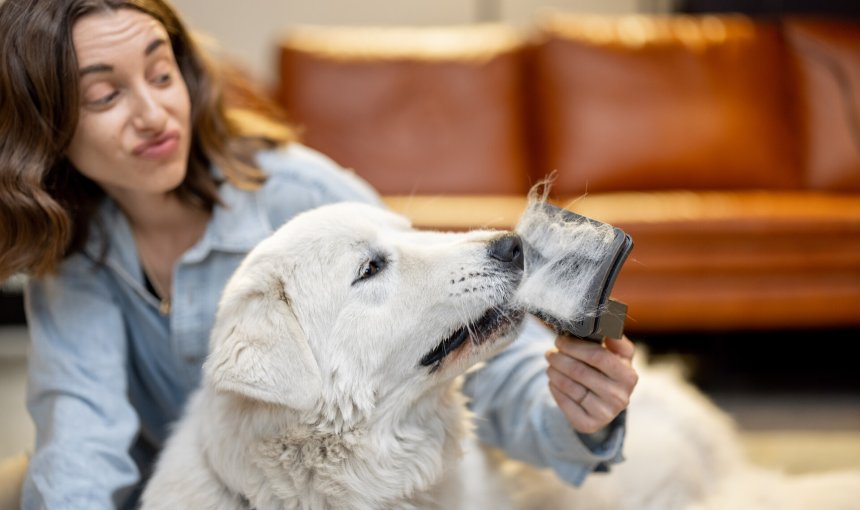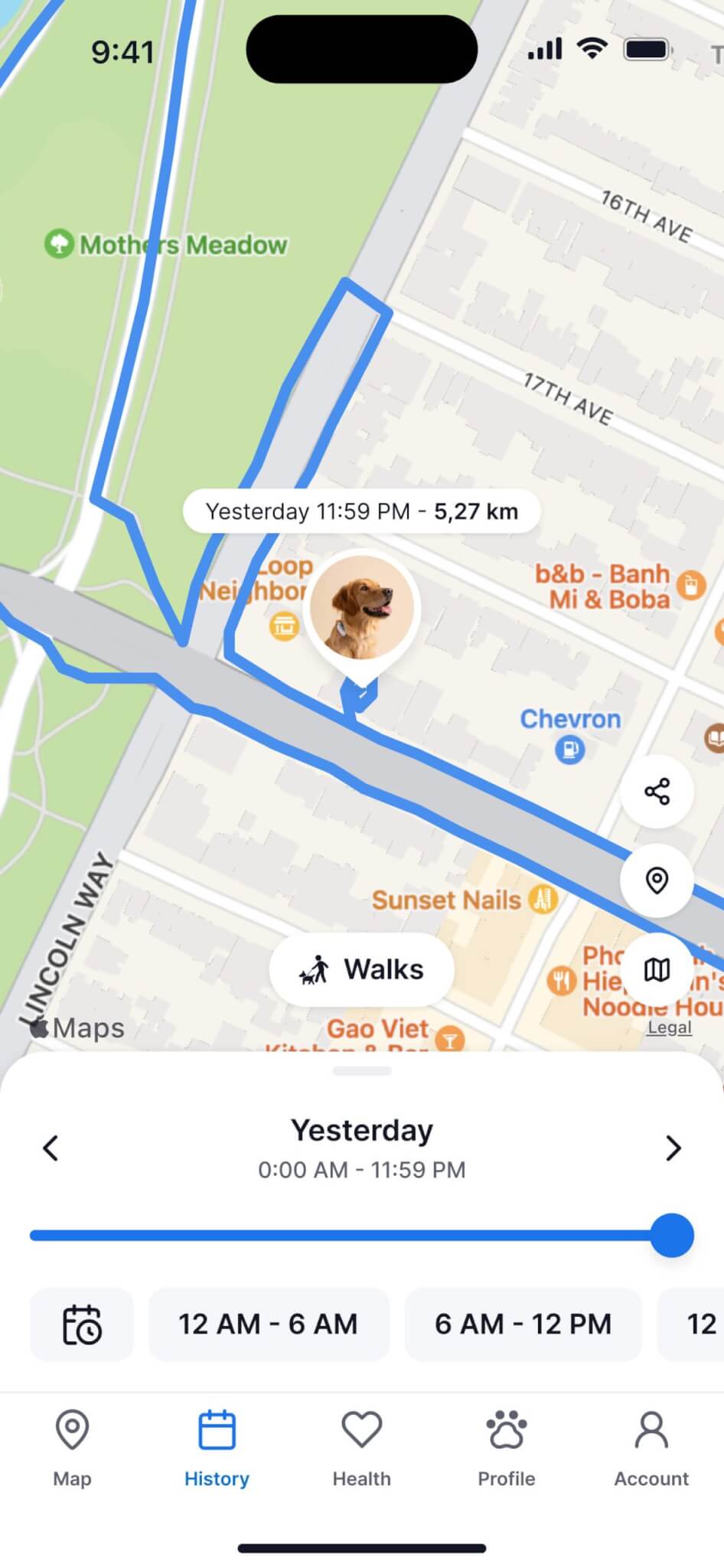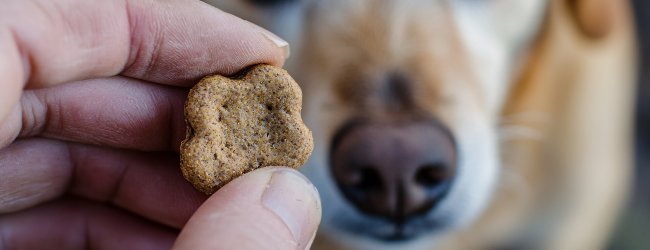 Approved by Dr. Dwight Alleyne, DVM
Approved by Dr. Dwight Alleyne, DVM Dog Losing Hair? Why It’s Happening & What To Do
If you're finding yourself vacuuming a new carpet of dog hair every so often...it might not just be seasonal shedding. Here are 5 key reasons why you've got a dog losing hair - and how to address them.

Got an apartment filled to the brim with dog hair? Or has your buddy been scratching themselves raw? While a bit of shedding is totally normal, a dog losing hair on a consistent basis may be a cause for concern. Here’s why it’s happening and how a smart dog tracker can help you better manage it.
Key Takeaways
A dog losing hair can be normal if it’s seasonal shedding or they’re just growing up. But if they’re losing hair in patchy spots and have scabs, it could be a sign of a bigger problem called “alopecia.”
Hair loss in patches is often caused by an infection from nasty bugs like mites, ticks, or fleas, or it could be an allergic reaction to food, pollen, or an insect bite. Head to your vet right away if you see these.
You can help prevent hair loss by grooming your dog regularly, reducing their stress, and keeping their indoor and outdoor areas clean.
The Tractive smart dog tracker can help you figure out what’s making your dog itchy. The Location History feature can show you if your dog’s favorite spots are also places where they might be picking up allergens or other pests.

Always know your buddy is healthy & safe
Read moreWhy is my dog losing hair? The less concerning reasons
Your dog might be losing hair because:
- They’re in heat.
Your unspayed girl dog might be releasing specific hormones that speed up the shedding process. If you’ve gotten her spayed, she might shed less. - They’re growing up.
Dogs tend to lose their fur as puppies – i.e., their original baby coat. After losing this baby coat, puppies grow their adult fur over a few weeks to a few months. - It’s seasonal shedding time.
Around twice a year, depending on their breed and age, almost every dog goes through the process of losing fur for 6-8 weeks. Changes in daylight and temperature send signals to your dog’s body for when it’s time for a thinner or thicker coat. - Your dog’s breed sheds more than others.
Depending on how thick their coats get, you might see more shedding from the Retriever family, Newfoundlands, Pekingese, Chow Chows, Akitas, Huskies, Corgis, Shepherds, Malamutes, and Finnish Lapphunds. These dogs tend to have thick undercoats to keep them warm in winter.
So remember: losing some amount of fur is 100% normal for your dog. This is especially so if they shed around specific times of the year.
Does my dog have alopecia?
If your dog is losing hair in patches and scabs, it could be a case of canine alopecia. Alopecia in dogs is different from seasonal shedding, which tends to be hair loss across your dog’s body. You might notice your dog scratching more than usual – or excessively. At times, they might end up losing fur with no scratching at all.
With time, this may lead to:
- Reddened, inflamed skin
- Red spots (called papules)
- Pustules
- Hives
- Oozing and/or bleeding
- Open wounds from excessive scratching
If you notice any of these signs, drop by your vet immediately to find out what’s causing it.
Why is my dog losing hair in patches and scabs?
An infection
Your dog’s environment is one of the key places they might pick up an infection. Including where they’re wandering outdoors, or if it’s too hot, moist, or dirty. So if you’ve got a dog that enjoys their outdoor time, it’s possible they might come into contact with critters like fleas, ticks, mites, bacteria, fungi, or even insects.
💡So if you’ve got a spotless indoor space, but your dog is an outdoor adventurer, it makes sense to keep track of their favorite hangout spots. Which might include your neighbors’ backyards (and their pets, whose fur may also have their own share of pests.) Else, consider any woodland areas around your property or even your local park, if these are areas you two spend a lot of time in together.

Follow your dog anywhere
Get real-time location information, wherever they go. And find out when they try to make an escape, or just when they go somewhere they shouldn’t, with Virtual Fences.
An allergy
Your dog might also be losing hair in patches due to an allergy. Including from:
- Inhalation, like if they come in contact with pollen or dander
- Contact, especially from other pets and wild animals
- Insects, especially if they’re bitten or stung
In some rare cases, your dog might end up itching excessively from a food allergy. (Including other signs like diarrhea and vomiting.)
Other causes
Aside from infections and allergies, here are some other reasons behind alopecia in dogs:
- Your dog’s genetic history, which may include atopy or a heightened sensitivity to developing allergies.
- Nutrition, especially if they’re deprived of specific vitamins
- Chemical exposure
- Burns
- Anxiety and/or stress
- An autoimmune disorder
- An endocrine disorder, including hypothyroidism
- Cancer
In some cases, your dog might also lose a patch of fur around a site they’ve been vaccinated. While it should normally be temporary, get in touch with your vet if it persists and the hair doesn’t grow back in a few weeks.
How your vet might diagnose alopecia in dogs
Your vet will begin by thoroughly examining your dog to find out the root cause of their hair loss. (As well as scout out any visible pests like ticks or mites.) Besides, make sure you go prepared with your dog’s medical history – including their:
- Age
- Breed
- Diet
- Any existing medical conditions you’re aware of
- Their outdoor habits, including whether they have a “job” – like herding cattle
- Their environment, including what they’re exposed to – like woodland, ponds, or other animals
- How many other pets you have at home
Your vet might also recommend the following tests to figure out what’s causing their hair loss:
- Skin scrapes to look out for signs of mange or a bacterial culture
- Black light to help them look out for fungal cultures
- An ear smear, which can help detect bacteria, yeast, and mites
- A skin test to check for allergies
- A blood test to check for endocrinal diseases
- A stool sample to check for parasites
In more serious cases, your dog might also have to undergo a biopsy to check for more serious health conditions like cancer.
What your vet might recommend to treat alopecia in dogs
Depending on what’s causing your dog to lose fur, your vet might recommend a change in your dog’s diet, especially if it’s triggered by a food allergy. These might include hypoallergenic dog foods, which are less likely to trigger a flareup. They’ll also prescribe you specific medications to help reduce itching and get rid of any infections or medically-approved products (like medicated shampoos.)
⚠️ Make sure to avoid using products designed for humans on your dog – no matter how badly they’re itching. In most cases, these products contain ingredients toxic to dogs and may even be fatal in some cases.
How to prevent your dog from losing hair – much in advance
Make regular grooming a priority
With regular brushing and bathtime, you can prevent your dog’s fur from matting and tangling. (All factors that make it easy for pests to find a new home.) This can also help you pick out scabs and lesions before your dog has a chance to scratch them even further and cause open wounds in the process, which can also get infected – worsening the problem.
Figure out if something’s stressing out your dog
A change in routine can majorly stress out your dog – including:
- Shifting apartments, cities, states, or even countries
- A new pet (or baby) coming home
- Grief, including losing a loved one (or if someone they’re used to moves out, on, or away)
- A change in your schedule, like if you’ve switched to a night shift and aren’t around at the “usual” times
- A change in habits, like if they’re not allowed to go outside anymore like they’re used to
In these cases, your dog’s stress (and shedding) may be temporary. But make sure to spend some extra quality time with them, so that they feel more secure and reassured. If you’re away from home for long hours, make sure to leave them a bunch of toys and treats to keep them happy and busy.
Clean up your indoor & outdoor space
This helps prevent any buildup of dust, dander, and other pests. Your backyard could do with a bit of treatment as well. Make sure to keep your greenery trimmed, including any grass, trees, or shrubs. Use household and yard sprays to treat your entire home and yard and consider hiring an exterminator if you have a severe problem.
Finally, check your dog for any critters – including ticks and mites, which are visible to the human eye – when you’re both back from walks or playtime outdoors.
Pay extra attention to your dog’s food
Besides sticking to any vet-prescribed change in diet, make sure to monitor who’s feeding your dog. Including what they’re eating and whether they’re sneaking out to find some extra “treats.” Because no matter how much of a good boy or good girl your dog is, there’s very little standing between a food-motivated dog and those extra nibbles. Whether it’s from a neighbor who doesn’t know what’s off-limits for them, one of your kids passing off their veggies to them…or the local garbage dump.
Where a smart dog tracker can help
Watching your dog lose fur is worrying, and pinpointing the exact cause can be tough. It could be allergies, pests, stress, or a health issue. That’s where a Tractive smart dog tracker can help you both figure out the “why” and tracking your dog’s overall well-being.
Strapped to your dog’s collar, you can now:
Figure out where your dog is off wandering outdoors
Check your dog’s Location History to see exactly where they spend their time. If the Heatmap shows they are constantly resting or rubbing up against a certain tree, bush, or patch of lawn, that area might be the source of a contact allergy or a localized pest problem. Identifying this risky spot helps you adjust your walks or fence off a part of the yard.

If the fur loss seems related to a new activity or place, use the LIVE tracking to see exactly what areas your dog is exploring during walks or backyard time. If the problem gets worse right after they visit a specific location, you have strong evidence to share with your vet.
Spot potential health issues early
Dogs that are itchy or uncomfortable (which leads to fur loss) rarely get good rest. Besides location, your tracker also monitors their activity and sleep quality. If they are constantly waking up or moving throughout the night because of irritation, the tracker will document that poor sleep. Similarly, if they are losing fur due to chronic stress, they might show unusual restlessness or a drop in activity.
With time, your tracker learns your dog’s normal patterns and sends you Health Alerts for sudden, big changes in their activity or sleep. You can also monitor their vital signs like heart and respiratory rate, which gives you helpful information to share with your vet. This data can help them diagnose your dog that much better.

Your furry friend’s health and wellbeing means as much as to us as it does to you. So we’ve made it a priority to only share medically-relevant content on our blog.
This post was checked, double-checked, and medically verified by Georgia-based vet, Dr. Dwight Alleyne.

Originally from Long Island, New York, Dr. Alleyne began his career at a no-kill animal shelter before becoming a licensed veterinary technician. He graduated from Cornell University Veterinary College in 2006 and completed an internship at Purdue University. Now practicing in Georgia, Dr. Alleyne specializes in soft tissue surgery and ultrasounds. He also writes pet health articles on his website, “The Animal Doctor Blog” (www.anmldrblog.com).



